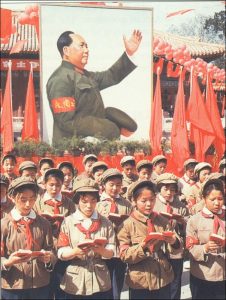Why did Mao launch the Cultural Revolution?
Mao had four main aims when he launched the Cultural Revolution:
- to replace his designated successors with leaders more faithful to his current thinking
- to reaffirm the role of the Chinese Communist Party
- to provide China’s youth with a revolutionary experience
- to achieve policy changes to make the educational, health care, and cultural systems less elitist.
The plan was put in place for a number of reasons. First, Mao was concerned about his own standing within the party and the way that he would be remembered. Second, he was not impressed with the way that changes were being made in the Soviet Union and he was determined to ensure that similar, softer, versions of Socialism were not adopted in China. To address both of these objectives he wanted a Cultural Revolution to challenge people’s thinking; provide younger party members with an opportunity to participate in revolutionary activity, thus revitalising their belief and enthusiasm and in doing so he would strengthen both his own position but also ensure that his vision for the future was the one that was adopted and followed in the coming years.
Sources
Source: The Sixteen Points: Guidelines for the Great Proletarian Cultural Revolution (1966)
Although the bourgeoisie has been overthrown, it is still trying to use the old ideas, culture, and customs, and habits of the exploiting classes to corrupt the masses, capture their minds, and endeavor to stage a comeback. The proletariat must do just the opposite: it must meet head-on every challenge of the bourgeoisie in the ideological field and use the new ideas, culture, customs, and habits of the proletariat to change the mental outlook of the whole of society. At present our objective is to struggle against and crush those persons in authority who are taking the capitalist road, to criticize and repudiate the reactionary bourgeois academic “authorities” and the ideology of the bourgeoisie and all other exploiting classes and transform education, literature, and art and all other parts of the superstructure that do not correspond to
the socialist economic base, so as to facilitate the consolidation and development of the socialist system.
The masses of the workers, peasants, soldiers, revolutionary intellectuals, and revolutionary cadres form the main force in this Great Cultural Revolution. Large numbers of revolutionary young people, previously unknown, have become courageous and daring pathbreakers. …
Source: The Sixteen Points: Guidelines for the Great Proletarian Cultural Revolution (1966)
Since the Cultural Revolution is a revolution, it inevitably meets with resistance. This
resistance comes chiefly from those in authority who have wormed their way into the party and
are taking the capitalist road. It also comes from the old force of habit in society. At present, this
resistance is still fairly strong and stubborn. However, the Great Proletarian Cultural
Revolution is, after all, an irresistible general trend. There is abundant evidence that such
resistance will crumble fast once the masses become fully aroused. …
Links
Thinkquest – The Cultural Revolution
Fortune City – The reasons for the Cultural Revolution
China News Digest – Virtual Museum
Zitanteque – posters and artwork from the Cultural Revolution

